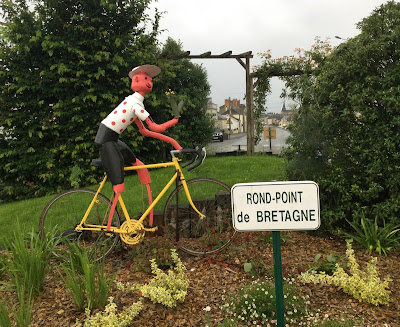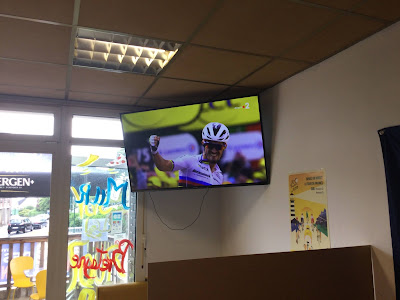Today was my first day of course markers from the very start to the very end. It was like being in the Land of Oz merrily having the way guided for me. Even before I left the campground I had the pleasure of spotting a course marker, as a Dutch guy walked by me carrying one that he’d just been gifted by the crew setting them up.
He happened to be out along the road when they came by and they generously obliged him with one. He was quite ecstatic, as he didn’t even realize The Tour would be passing this very spot the next day. He’d witnessed The Tour in years past, so well knew a course marker was a sacred object, but he wasn’t such a diehard of a fan to know his vacation would intersect with The Tour.
My start was slightly delayed by more rain. Once again I had to roll up a dripping wet tent. The day remained overcast, but there was only one light drizzle. The Brittany-effect continues. It is said that a visitor to Brittany became so exasperated by the inclement weather he asked a boy, “Does the sun ever shine here?”
He replied, “I’m only eleven, I don’t know.”
But the day was brightened by every course marker. They came in bunches at sharp ninety-degree turns, any of which could level an inattentive peloton.
Since it was a time trial it would give me the opportunity to watch unhindered all of the contenders, and to assess those who were recovering from crashes. Roglic turned up at yesterday’s stage wrapped like a mummy. There was concern if he could rest his elbows on the aero bars of his time trial bike.
Geraint Thomas had been a favorite for the stage. But after his dislocated shoulder two stages ago, it is almost a miracle he is still riding. Johann Bruyneel gave Ineos great credit for having a chiropractor in one of its team cars who could adeptly snap it back in place. That is another example of the team’s extra attention to detail, helped by its budget second to none, that has made it the dominant team the past decade.
Roglic and Thomas didn’t have dominant time trials, as they often do, Roglic losing 44 seconds and Thomas one minute and eighteen seconds to the winner Pogacar, but it could have been worse. Van der Poel managed to hold on to the Yellow Jersey by eight seconds over Pogacar with Van Aert moving up to third thirty seconds bsck. Bruyneel picked his fellow Belgian Van Aert to win the time trial and take the Yellow Jersey from his arch cyclecross rival Van der Poel, but Van der Poel rode strongly, just one second behind Van Aert, to keep him at bay and to avoid that somewhat nightmare scenario.
I had another bartender give me a gift. This time it was an FDJ key-chain, a trinket that could be caravan fare, representative of one of the French teams in The Tour. The bartender said tomorrow would just be the second time he had ever seen The Tour. The first was in 2004 when he was living in another region of France. I commented that was when Armstrong dominated The Race. He made a gesture of injecting himself and said, “That was when they took drugs to go fast. Now they have motors.”
Shortly after the bar I began the lone categorized climb of the stage, a mere hiccup of 2.2 kilometers at a 2.9 per cent grade, no doubt the most incidental of categorized climbs in the entire race. Two women on e-bikes flew past me, one a teen and the other someone who could have been her grandmother













































